Organic Waste from the Management of the Invasive Oxalis pes-caprae as a Source of Nutrients for Small Horticultural Crops
Abstract
1. Introduction
2. Results
2.1. Plant Height, Biomass and Relative Water Content of Wild Rocket
2.2. Gas Exchange, Chlorophyl a Fluorescence, and Pigment Contents of Wild Rocket
2.3. Total Soluble Sugars and Starch of Wild Rocket
2.4. Soil Nutrients
2.5. Multivariate Analysis
3. Discussion
4. Materials and Methods
4.1. Plant Material and Soil Collection and Preparation
4.2. Experimental Set-Up, Stress Implementation, and Biometric Parameters Analysis
4.3. Determination of Wild Rocket Water Status, Photosynthesis, and Pigment Levels
4.4. Wild Rocket Carbohydrate Contents
4.5. Antioxidant Contents in Wild Rocket Leaves
4.6. Evaluation of Soil Nutrients during Oxalis Waste Decomposition
4.7. Statistical Analyses
5. Conclusions
Author Contributions
Funding
Data Availability Statement
Acknowledgments
Conflicts of Interest
References
- Le Maitre, D.C.; Gaertner, M.; Marchante, E.; Ens, E.J.; Holmes, P.M.; Pauchard, A.; O’Farrell, P.J.; Rogers, A.M.; Blanchard, R.; Blignaut, J.; et al. Impacts of invasive Australian acacias: Implications for management and restoration. Diver. Distrib. 2011, 17, 1015–1029. [Google Scholar] [CrossRef]
- Pyšek, P.; Jarošik, V.; Hulme, P.E.; Pergl, J.; Hejda, M.; Schaffner, U.; Vila, M. A global assessment of invasive plant impacts on resident species, communities and ecosystems: The interaction of impact measures, invading species’ traits and environment. Glob. Chang. Biol. 2012, 18, 1725–1737. [Google Scholar] [CrossRef]
- Pyšek, P.; Hulme, P.E.; Simberloff, D.; Bacher, S.; Blackburn, T.M.; Carlton, J.T.; Dawson, W.; Essl, F.; Foxcroft, L.C.; Genovesi, P.; et al. Scientists’ warning on invasive alien species. Biol. Rev. 2020, 95, 1511–1534. [Google Scholar] [CrossRef]
- Souza-Alonso, P.; Rodriguez, J.; Gonzalez, L.; Lorenzo, P. Here to stay. Recent advances and perspectives about Acacia invasion in Mediterranean areas. Ann. For. Sci. 2017, 74, 55–75. [Google Scholar] [CrossRef]
- Lorenzo, P.; Morais, M.C. Strategies for the management of aggressive invasive plant species. Plants 2023, 12, 2482. [Google Scholar] [CrossRef]
- Ulm, F.; Estorninho, M.; de Jesus, J.G.; de Sousa Prado, M.G.; Cruz, C.; Máguas, C. From a lose–lose to a win–win situation: User-friendly biomass models for Acacia longifolia to aid research, management and valorisation. Plants 2022, 11, 2865. [Google Scholar] [CrossRef]
- Vilà, M.; Bartomeus, I.; Gimeno, I.; Traveset, A.; Moragues, E.V.A. Demography of the invasive geophyte Oxalis pes-caprae across a Mediterranean island. Ann. Bot. 2006, 97, 1055–1062. [Google Scholar] [CrossRef]
- Costa, J.; Ferrero, V.; Castro, M.; Jorge, A.; Afonso, A.; Loureiro, J.; Castro, S. Pollen flow between flowers of the same morph in invasive populations of Oxalis pes-caprae L. in the western Mediterranean region. Plant Biosyst. Int. J. Deal. Asp. Plant Biol. 2016, 150, 923–931. [Google Scholar] [CrossRef]
- Ferrero, V.; Navarro, L.; Castro, S.; Loureiro, J.; Sánchez, J.M.; Carvallo, G.O.; Barrett, S.C. Global patterns of reproductive and cytotype diversity in an invasive clonal plant. Biol. Invasions 2020, 22, 1691–1703. [Google Scholar] [CrossRef]
- Pedraja, O.S. Oxalis L. In Flora Iberica IX; Castroviejo, S., Muñoz Garmendia, F., Navarro, C., Quintanar, A., Buira, A., Eds.; Real Jardín Botánico, CSIC: Madrid, Spain, 2015; Volume 9, p. 564. [Google Scholar]
- Castro, S.; Ferrero, V.; Costa, J.; Sousa, A.J.; Castro, M.; Navarro, L.; Loureiro, J. Reproductive strategy of the invasive Oxalis pes-caprae: Distribution patterns of floral morphs, ploidy levels and sexual reproduction. Biol. Invasions 2013, 15, 1863–1875. [Google Scholar] [CrossRef]
- Ferrero, V.; Barrett, S.C.H.; Castro, S.; Caldeirinha, P.; Navarro, L.; Loureiro, J.; Rodríguez-Echeverría, S. Invasion genetics of the Bermuda buttercup (Oxalis pes-caprae): Complex intercontinental patterns of genetic diversity, polyploidy and heterostyly characterize both native and introduced populations. Mol. Ecol. 2015, 24, 1927–1941. [Google Scholar] [CrossRef]
- Lorenzo, P.; González, L.; Ferrero, V. Effect of plant origin and phenological stage on the allelopathic activity of the invasive species Oxalis pes-caprae. Am. J. Bot. 2021, 108, 971–979. [Google Scholar] [CrossRef]
- Gallardo, B. Europe’s top 10 invasive species: Relative importance of climatic, habitat and socio-economic factors. Ethol. Ecol. Evol. 2014, 26, 130–151. [Google Scholar] [CrossRef]
- Gimeno, I.; Vila, M.; Hulme, P.E. Are islands more susceptible to plant invasion than continents? A test using Oxalis pes-caprae L. in the western Mediterranean. J. Biogeogr. 2006, 33, 1559–1565. [Google Scholar] [CrossRef]
- Lazzaro, L.; Ferretti, G.; Bianchi, E.; Benesperi, R. Treatment by glyphosate-based herbicide allowed recovering native species after Oxalis pes-caprae L. invasion: Indications from a Mediterranean island. Plant Biosyst. Int. J. Deal. Asp. Plant Biol. 2019, 153, 651–659. [Google Scholar] [CrossRef]
- BioDiversity4All. Available online: https://www.biodiversity4all.org/taxa/53169-Oxalis-pes-caprae (accessed on 20 March 2024).
- Tavares, D.; Loureiro, J.; Martins, A.; Castro, M.; Roiloa, S.; Castro, S. Genetically based phenotypic differentiation between native and introduced tetraploids of Oxalis pes-caprae. Biol. Invasions 2019, 21, 229–243. [Google Scholar] [CrossRef]
- Pierce, J.R. The biology of Australian weeds 31 Oxalis pes-caprae L. Plant Prot. Q. 1997, 12, 110–119. [Google Scholar]
- Torretta, V.; Katsoyiannis, I.A.; Viotti, P.; Rada, E.C. Critical review of the effects of glyphosate exposure to the environment and humans through the food supply chain. Sustainability 2018, 10, 950. [Google Scholar] [CrossRef]
- Muñoz, M.; Torres-Pagán, N.; Jouini, A.; Araniti, F.; Sánchez-Moreiras, A.M.; Verdeguer, M. Control of problematic weeds in Mediterranean vineyards with the bioherbicide pelargonic acid. Agronomy 2022, 12, 2476. [Google Scholar] [CrossRef]
- Kluge, R.L.; Claassens, M. Klugeana philoxalis Geertsema (Noctuidae: Cuculliinae), the first potential biological control agent for the weed Oxalis pes-caprae L. J. Entomol. Soc. South. Afr. 1990, 53, 191–198. [Google Scholar]
- Hulme, P.E. Invasions, islands and impacts: A Mediterranean perspective. In Island Ecology; Fernández-Palacios, J.M., Morici, C., Eds.; Asociación Española de Ecología Terrestre: Madrid, Spain, 2024; pp. 359–383. [Google Scholar]
- Herbert, E.W.; Dittmer, K.E. Acute and chronic oxalate toxicity in Miniature Horses associated with soursob (Oxalis pes-caprae) ingestion. Equine Vet. Educ. 2017, 29, 549–557. [Google Scholar] [CrossRef]
- Volakakis, N.; Kabourakis, E.M.; Rempelos, L.; Kiritsakis, A.; Leifert, C. Effect of different cover crops on suppression of the weed Oxalis pes-caprae L., soil nutrient availability, and the performance of table olive trees ‘Kalamon’ cv. in Crete, Greece. Agronomy 2022, 12, 2523. [Google Scholar] [CrossRef]
- MITECO 2013. Catálogo Español de Especies Exóticas Invasoras. Oxalis pes-caprae L. OXAPES/EEI/FL06X. Available online: https://www.miteco.gob.es/content/dam/miteco/es/biodiversidad/temas/conservacion-de-especies/Oxalis_pes-caprae_2013_tcm30-69848.pdf (accessed on 20 March 2024).
- Sala, A.; Verdaguer, D.; Vilà, M. Sensitivity of the invasive geophyte Oxalis pes-caprae to nutrient availability and competition. Ann. Bot. 2007, 99, 637–645. [Google Scholar] [CrossRef] [PubMed]
- Cannon, J.P.; Allen, E.B.; Allen, M.F.; Dudley, L.M.; Jurinak, J.J. The effects of oxalates produced by Salsola tragus on the phosphorous nutrition of Stipa pulchra. Oecologia 1995, 102, 265–272. [Google Scholar] [CrossRef] [PubMed]
- Xue, J.; San Zhou, S.; Wang, W.; Huo, L.; Zhang, L.; Fang, X.; Zhihong Yang, Z. Water availability effects on plant growth, seed yield, seed quality in Cassia obtusifolia L., a medicinal plant. Agric. Water Manag. 2018, 195, 104–113. [Google Scholar] [CrossRef]
- Dias, M.C.; Azevedo, C.; Costa, M.; Pinto, G.; Santos, C. Melia azedarach plants show tolerance properties to water shortage treatment: An ecophysiological study. Plant Physiol. Biochem. 2014, 75, 123–127. [Google Scholar] [CrossRef]
- Carstensen, A.; Herdean, A.; Schmidt, S.B.; Sharma, A.; Spetea, C.; Pribil, M.; Husted, S. The Impacts of phosphorus deficiency on the photosynthetic electron transport chain. Plant Physiol. 2018, 177, 271–284. [Google Scholar] [CrossRef]
- Tariq, A.; Pan, K.; Olatunji, O.A.; Graciano, C.; Li, Z.; Sun, F.; Sun, X.; Song, D.; Chen, W.; Zhang, A.; et al. Phosphorous application improves drought tolerance of Phoebe zhennan. Front. Plant Sci. 2017, 8, 663–676. [Google Scholar] [CrossRef]
- Attarzadeh, M.; Balouchi, H.; Rajaie, M.; Movahhedi Dehnavi, M.; Salehi, A. Growth and nutrient content of Echinacea purpurea as affected by the combination of phosphorus with arbuscular mycorrhizal fungus and pseudomonas florescent bacterium under different irrigation regimes. J. Environ. Manag. 2019, 231, 182–188. [Google Scholar] [CrossRef]
- Khan, F.; Siddique, A.B.; Shabala, S.; Zhou, M.; Zhao, C. Phosphorus plays key roles in regulating plants’ physiological responses to abiotic stresses. Plants 2023, 12, 2861. [Google Scholar] [CrossRef]
- Kayoumu, M.; Iqbal, A.; Muhammad, N.; Li, X.; Li, L.; Wang, X.; Gui, H.; Qi, Q.; Ruan, S.; Guo, R.; et al. Phosphorus availability affects the photosynthesis and antioxidant system of contrasting low-P-tolerant cotton genotypes. Antioxidants 2023, 12, 466. [Google Scholar] [CrossRef] [PubMed]
- Ortega, Z.; Romero, F.; Paz, R.; Suárez, L.; Benítez, A.N.; Marrero, M.D. Valorization of invasive plants from Macaronesia as filler materials in the production of natural fiber composites by rotational molding. Polymers 2021, 13, 2220. [Google Scholar] [CrossRef]
- Lorenzo, P.; Guilherme, R.; Barbosa, S.; Ferreira, A.J.; Galhano, C. Agri-food waste as a method for weed control and soil amendment in crops. Agronomy 2022, 12, 1184. [Google Scholar] [CrossRef]
- Sims, D.; Gamon, J. Relationships between leaf pigment content and spectral reflectance across a wide range of species, leaf structures and developmental stages. Remote Sens. Environ. 2002, 81, 337–354. [Google Scholar] [CrossRef]
- Irigoyen, J.J.; Emerich, D.W.; Sanchezdiaz, M. Water stress induced changes in concentrations of proline and total soluble sugars in nodulated alfalfa (Medicago sativa) plants. Physiol. Plant. 1992, 84, 55–60. [Google Scholar] [CrossRef]
- Osaki, M.; Shinano, T.; Tadano, T. Redistribution of carbon and nitrogen compounds from the shoot to the harvesting organs during maturation in field crops. Soil Sci. Plant Nutr. 1991, 37, 117–128. [Google Scholar] [CrossRef]
- Re, R.; Pellegrini, N.; Proteggente, A.; Pannala, A.; Yang, M.; Rice-Evans, C. Antioxidant activity applying an improved ABTS radical cation decolorization assay. Free Radic. Biol. Med. 1999, 26, 1231–1237. [Google Scholar] [CrossRef]
- López-Orenes, A.; Dias, M.C.; Ferrer, M.A.; Calderón, A.; Moutinho-Pereira, J.; Correia, C.; Santos, C. Different mechanisms of the metalliferous Zygophyllum fabago shoots and roots to cope with Pb toxicity. Environ. Sci. Pollut. Res. 2018, 25, 1319–1330. [Google Scholar] [CrossRef]
- Giertych, M.J.; Karolewski, P.; de Temmerman, L.O. Foliage age and pollution alter content of phenolic compounds and chemical elements in Pinus nigra needles. Water Air Soil Pol. 1999, 110, 363–377. [Google Scholar] [CrossRef]
- Allen, S.E.; Grimshaw, H.M.; Rowland, A.P. Chemical Analysis. In Methods of Plant Ecology; Moore, P.D., Chapman, S.B., Eds.; Blackwell: Oxford, UK, 1986; pp. 285–344. [Google Scholar]
- R Development Core Team. R: A Language and Environment for Statistical Computing; R Foundation for Statistical Computing: Vienna, Austria, 2015. [Google Scholar]
- ter Braak, C.J.F.; Smilauer, P. CANOCO Reference Manual and User’s Guide to Canoco for Windows—Software for Canonical Community Ordination (Version 4); Microcomputer Power: Ithaca, NY, USA, 1998. [Google Scholar]
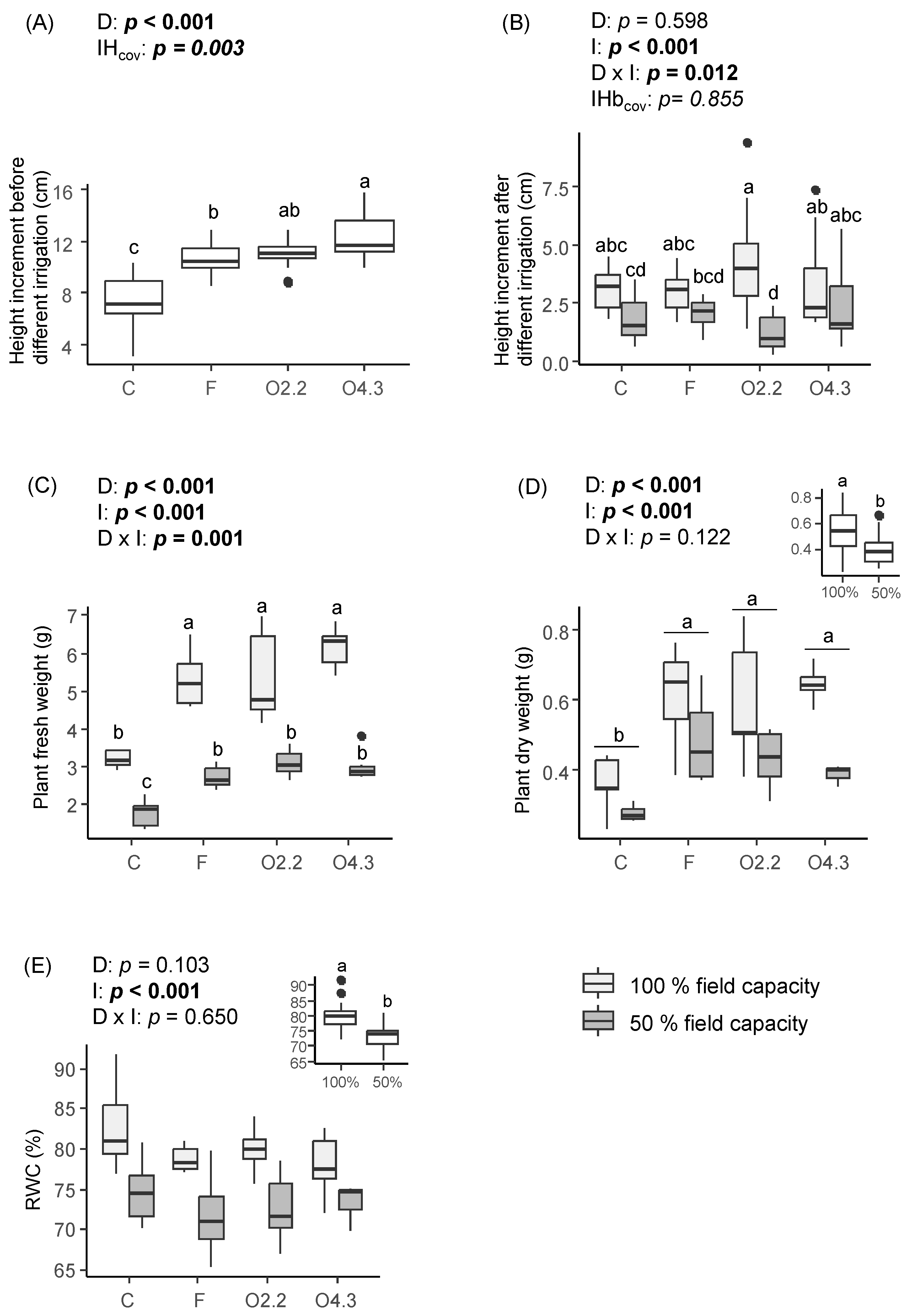
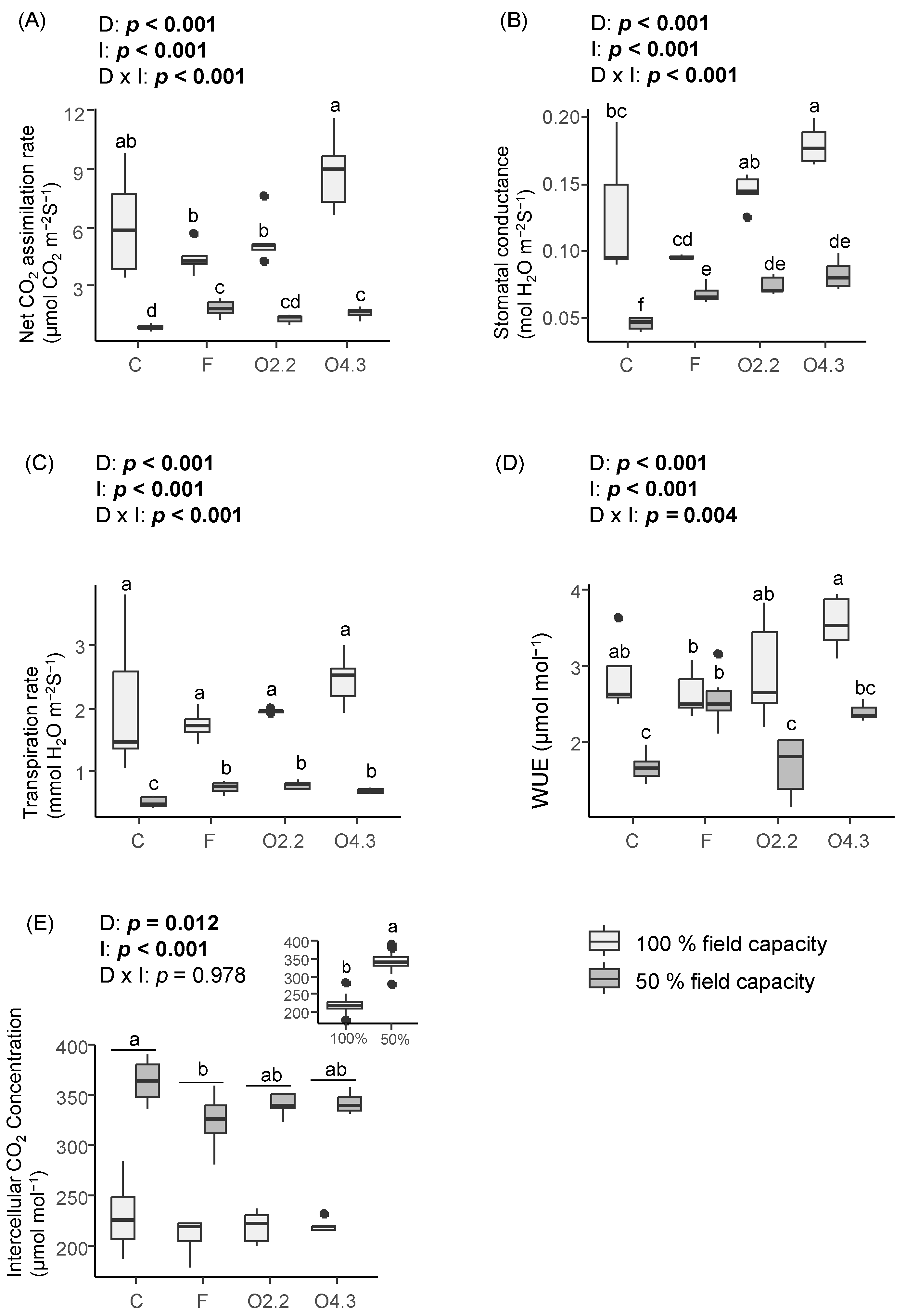

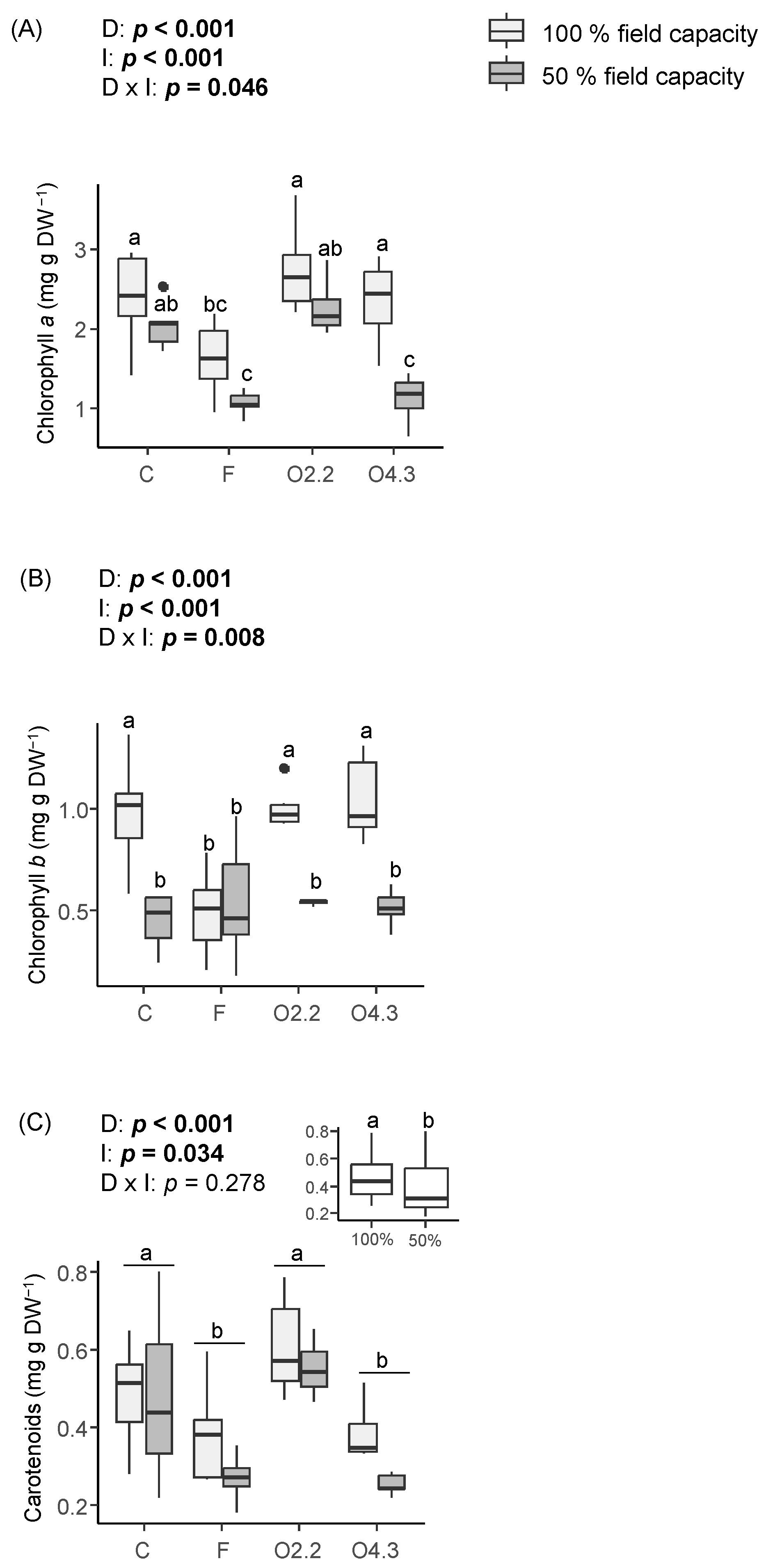
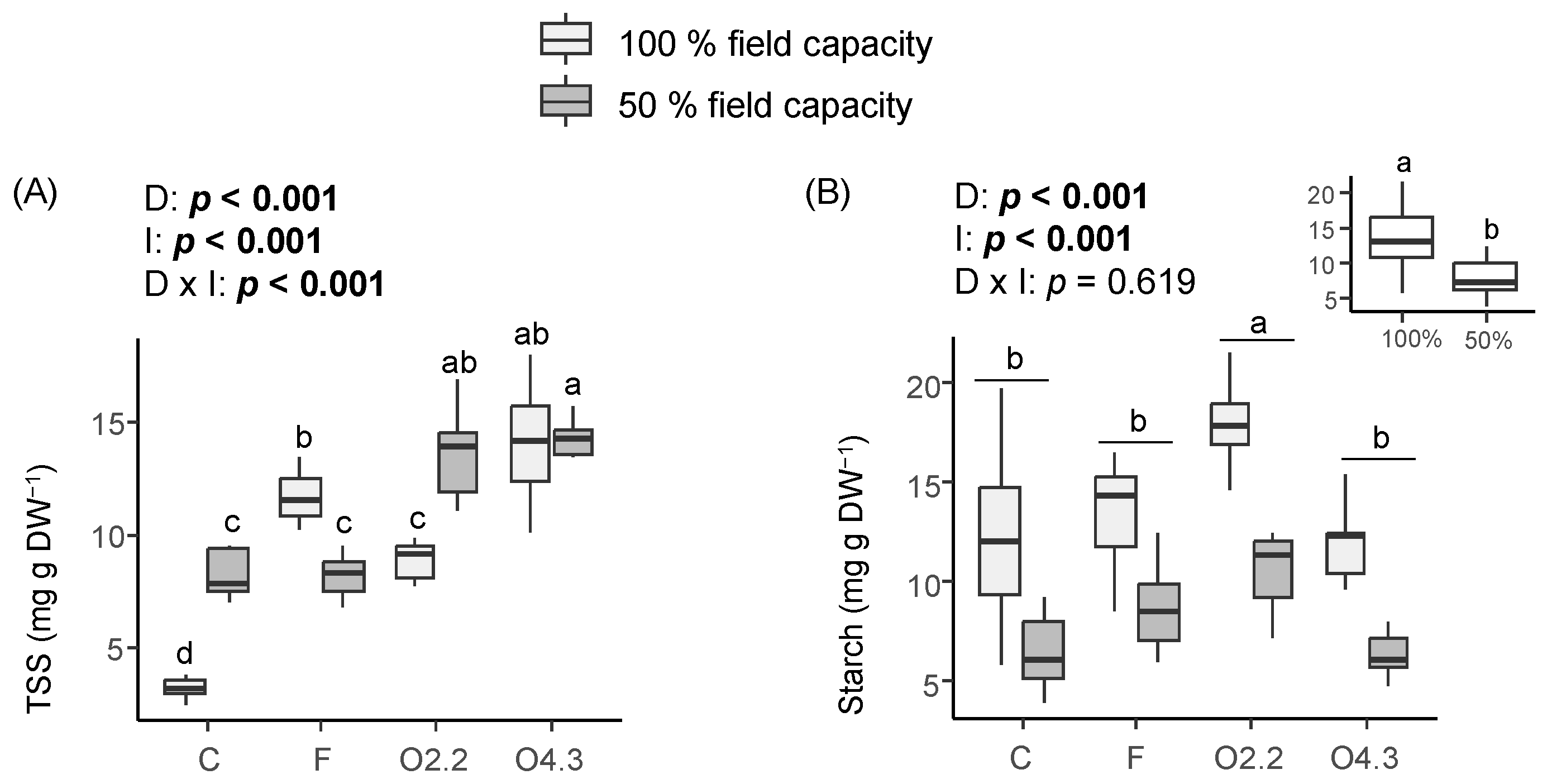
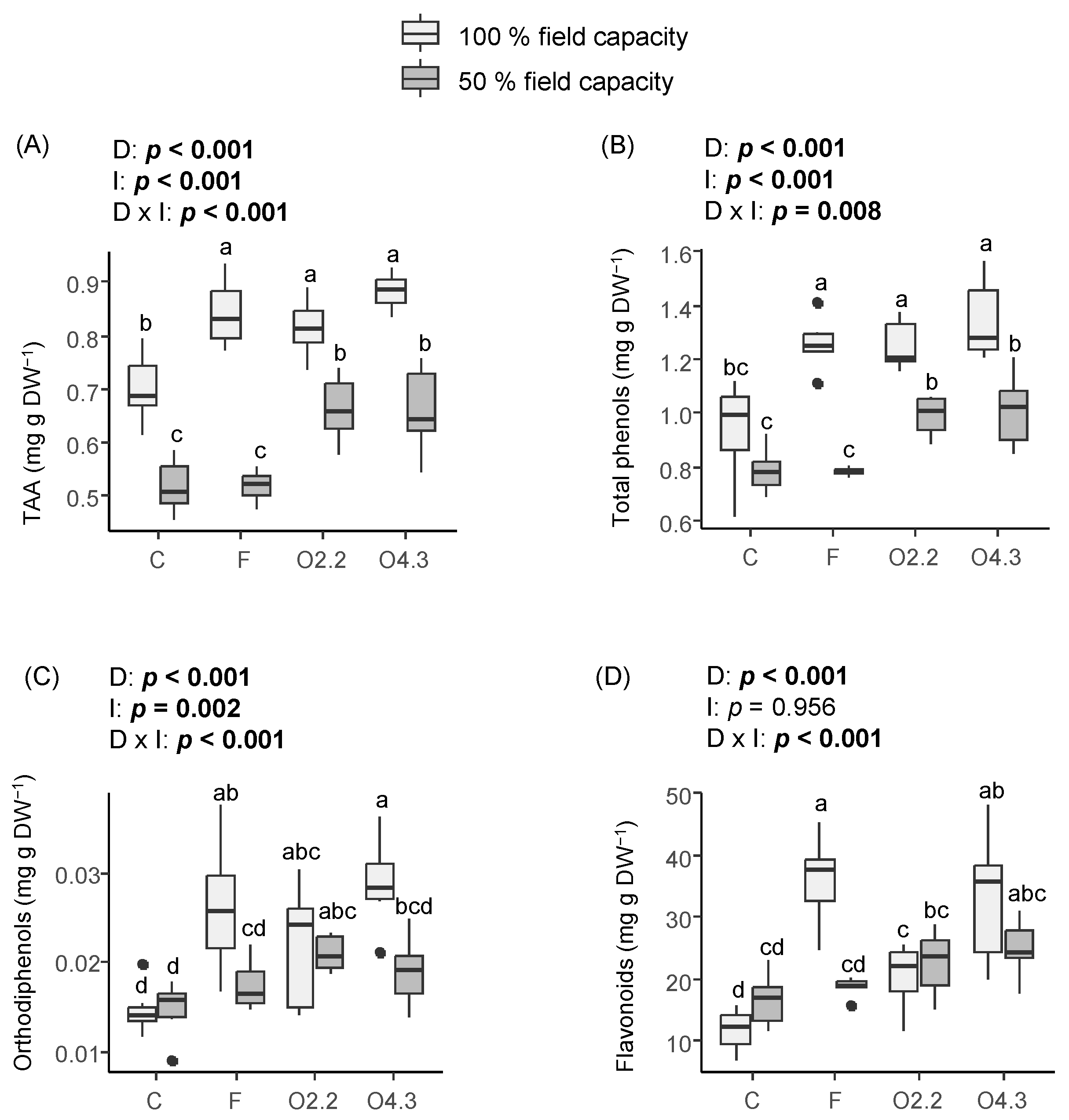
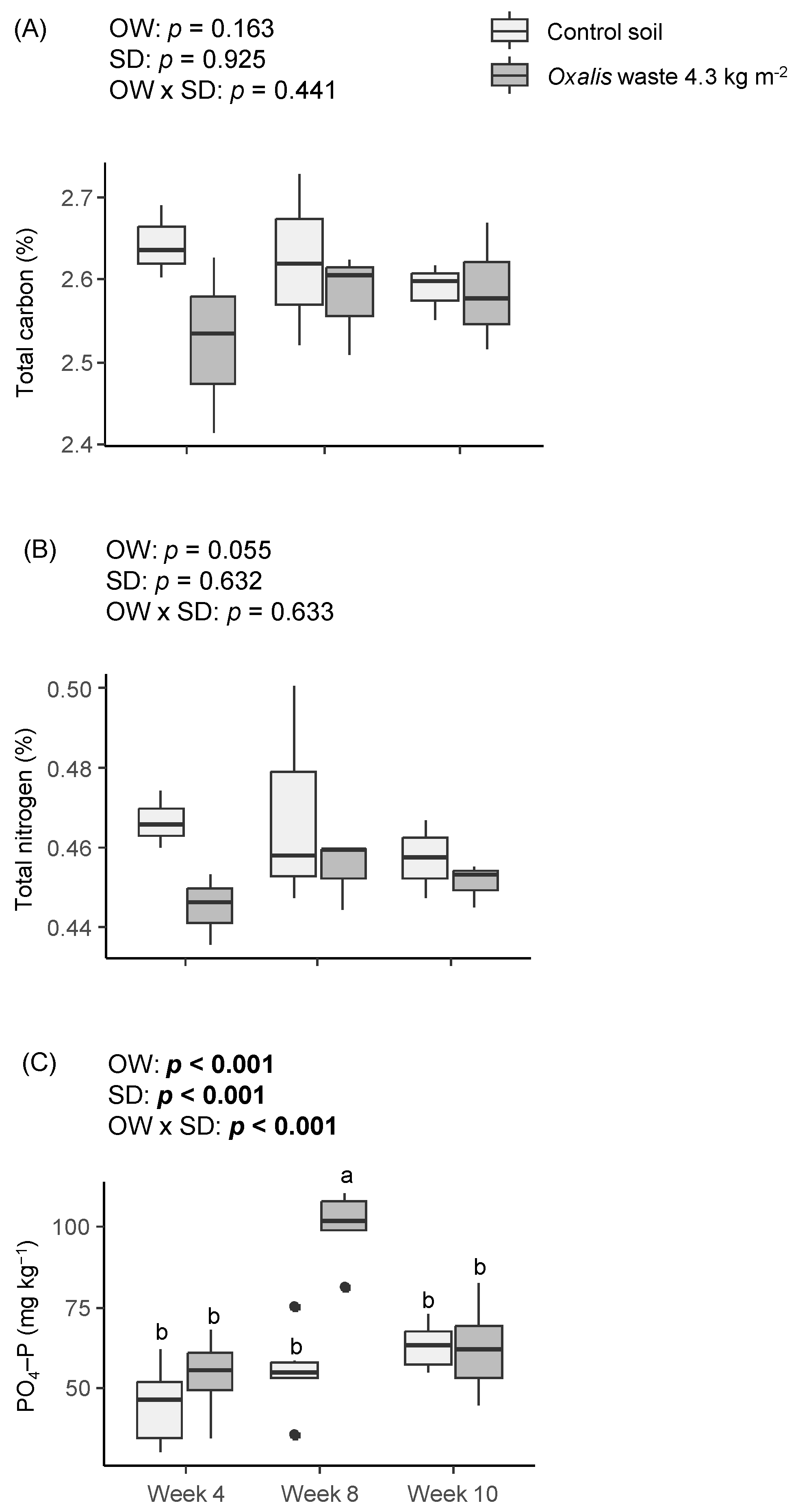

Disclaimer/Publisher’s Note: The statements, opinions and data contained in all publications are solely those of the individual author(s) and contributor(s) and not of MDPI and/or the editor(s). MDPI and/or the editor(s) disclaim responsibility for any injury to people or property resulting from any ideas, methods, instructions or products referred to in the content. |
© 2024 by the authors. Licensee MDPI, Basel, Switzerland. This article is an open access article distributed under the terms and conditions of the Creative Commons Attribution (CC BY) license (https://creativecommons.org/licenses/by/4.0/).
Share and Cite
Lorenzo, P.; Galhano, C.; Dias, M.C. Organic Waste from the Management of the Invasive Oxalis pes-caprae as a Source of Nutrients for Small Horticultural Crops. Plants 2024, 13, 2358. https://doi.org/10.3390/plants13172358
Lorenzo P, Galhano C, Dias MC. Organic Waste from the Management of the Invasive Oxalis pes-caprae as a Source of Nutrients for Small Horticultural Crops. Plants. 2024; 13(17):2358. https://doi.org/10.3390/plants13172358
Chicago/Turabian StyleLorenzo, Paula, Cristina Galhano, and Maria Celeste Dias. 2024. "Organic Waste from the Management of the Invasive Oxalis pes-caprae as a Source of Nutrients for Small Horticultural Crops" Plants 13, no. 17: 2358. https://doi.org/10.3390/plants13172358
APA StyleLorenzo, P., Galhano, C., & Dias, M. C. (2024). Organic Waste from the Management of the Invasive Oxalis pes-caprae as a Source of Nutrients for Small Horticultural Crops. Plants, 13(17), 2358. https://doi.org/10.3390/plants13172358








